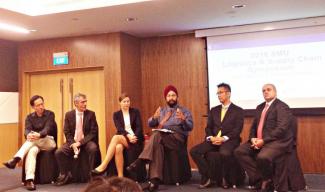
To bring sustainability to the supply chain, companies may first need to rethink their existing business models, according to speakers at the 2016 Logistics & Supply Chain Symposium.

Photo Credit: Nurfilzah Rohaidi
By Nurfilzah Rohaidi
SMU Office of Research – From diapers to mobile phones, disposable items designed to improve our lives are unfortunate emblems of our ‘throwaway culture’.
The World Bank estimates that by 2025, each urban resident will produce an average of 1.42 kg of municipal solid waste per day—more than twice the average ten years ago—because our industrial economy is largely based on a linear model of resource consumption that follows a ‘take-make-dispose’ pattern.
The circular economy, on the other hand, is designed to be zero-waste, or at least, one that produces as little waste as possible. Not only does it promise production cost savings in the long run, it also equals less dependence on our fast-depleting natural resources.
Notably, logistics plays a fundamental role as an enabler for the circular economy, according to speakers at the 2016 Singapore Management University (SMU) Logistics & Supply Chain Symposium: Urban Mobility & Circular Economy. The event, which took place on March 7, 2016, was co-organised by SMU, the Fujitsu-SMU Urban Computing and Engineering (UNiCEN) Corp Lab, and the DHL-SMU Green Transformation Lab (GTL).
The opening address was given by Mr. Robert Yap, deputy chairman and executive director of Y3 Technologies. Keynote speakers were Dr. Hee Limin, director of research at the Singapore Centre for Liveable Cities, and Ms. Katharina Tomoff, vice president (Shared Value & GoGreen) at Deutsche Post DHL Group.
Joining Ms. Tomoff at a panel discussion on the challenges and opportunities of urban management and the circular economy were Dr. Lieven Demeester, associate dean of MBA programmes at SMU; Dr. Cheng, associate professor of information systems at SMU; Mr. Arun Madhok, CEO of Suntec Singapore Convention & Exhibition Centre; and Mr. Rio Yamaura, vice president of the new solution business division at Fujitsu Asia. The panel was moderated by Mr. Karmjit Singh, chairman of The Chartered Institute of Logistics & Transport, Singapore.
Staying profitable by closing the loop
The key to developing a more sustainable business model without compromising on profitability is to scrutinise every part of a product’s life cycle and identify ways to ‘close the loop’, says Professor Demeester. Here, manufacturers can recycle valuable raw materials from end-of-life products and remanufacture them into new products.
“Parties from the different parts of the supply chain must come together to first envision what the model would look like, before they can figure out how to make the parts work together to create value,” he says.
In this new economy, entrepreneurs likely to succeed are the ones who can effectively bring the supply chain together with manufacturers, materials producers and then, potentially, regulators, according to Professor Demeester. “If you can bring all the elements together and be the ‘glue’, then you can be successful.”
Limitations and incentives
From the viewpoint of a service provider, Ms. Tomoff notes that industry regulations have a huge part to play in incentivising a circular economy.
“For some countries, a well-meant regulation hindered us from introducing electric vehicles. For example, with the battery on board, the weight of the vehicle exceeded the license category—of up to 3.5 tons in Germany,” she says.
This introduced a whole new set of challenges that Deutsche Post DHL Group’s environmental protection programme GoGreen could not anticipate at the time. As a result, their drivers had to go through costly training for a different license category—up to €4,000 per driver—that also took them out of operations for a while.
Ms. Tomoff emphasises that it is important to not only wait for regulations, but to develop innovative solutions with and for customers. “For one of our customers, we’ve designed a solution to manage food waste from airline catering. The recovery of food and packaging waste has helped our customer achieve its zero to landfill target.”
However, even well-designed regulations might prove ineffective sometimes if human behaviour isn’t taken into account, Dr. Cheng points out. This is particularly crucial when governments attempt to enhance urban mobility.
He cites the example of Electronic Road Pricing gantries in Singapore. “Their original purpose was to reduce congestion on the roads by charging road users based on time-specific rates,” he says, “but what you see from traffic patterns is that people would try to find ways to avoid those charges, for example by driving slower, or to make longer detours, and in the process generating unexpected congestions elsewhere.”
Greater efficiency through technology
Companies are constantly looking for ways to reduce costs and increase the efficiency of transporting and delivering recycled materials. This is where technological solutions could come in handy, says Mr. Yamaura.
To illustrate his point, he brings up the stringent recycling-related legislations implemented in Tokyo, where one can throw away a certain kind of waste only on designated days. However, this segmented waste system created a very complex logistical issue—just imagine how many logistics companies need to work together to collect the waste.
In situations like these, municipal service providers can apply data analytics and technology to increase the efficiency of waste collection and distribution to recycling centres, he says.
But as with any type of technology, he warns that security can become a sticking point. “The key question here is: are you happy if all of your waste is tracked? … For everyone to jump into the IoT (Internet of Things) pool [for a swim], you have to have a very secure pool first.”
Wrapping up the discussion, panel moderator Mr. Karmjit Singh returns to the topic of sustainability. “We are using too much resources. How do we save the planet? [How do we] use less resources to produce more? This requires major rethinking at the design stage; that’s where the challenges lie.”